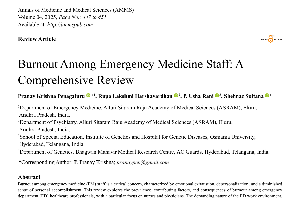##plugins.themes.bootstrap3.article.main##
Abstract
Burnout among emergency medicine (EM) staff is a critical concern, characterized by emotional exhaustion, depersonalization, and a diminished sense of personal accomplishment. This review explores the prevalence, contributing factors, and consequences of burnout among emergency department (ED) healthcare professionals, with a particular focus on nurses and physicians. The demanding nature of the ED work environment, including high patient loads, understaffing, and excessive administrative responsibilities, significantly contributes to burnout. Emotional and psychological stressors, such as frequent exposure to critically ill patients and traumatic events, further exacerbate the problem. Additionally, the COVID-19 pandemic intensified burnout due to increased workloads, fear of infection, and inadequate protective resources. Studies suggest that addressing burnout requires systemic interventions, including improved staffing policies, enhanced mental health support, and workplace modifications to mitigate stressors. Understanding these factors is essential for developing effective strategies to enhance the well-being of EM staff and improve patient care outcomes.
##plugins.themes.bootstrap3.article.details##
Copyright (c) 2025 Pranay Krishna Penagaluru, Rupa Lakshmi Harshavardhan, P. Usha Rani, Shehnaz Sultana

This work is licensed under a Creative Commons Attribution 4.0 International License.
Creative Commons License All articles published in Annals of Medicine and Medical Sciences are licensed under a Creative Commons Attribution 4.0 International License.
[1] Gómez-Urquiza JL, De la Fuente-Solana EI, Albendín-García L, Vargas-Pecino C, Ortega-Campos EM, Cañadas-De la Fuente GA. Prevalence of burnout syndrome in emergency nurses: A meta-analysis. Crit Care Nurse. 2017;37(5):e1-e9. doi: 10.4037/ccn2017508.
[2] Hetherington D, Wilson NJ, Dixon K, Murphy G. Emergency department nurses' narratives of burnout: Changing roles and boundaries. Int Emerg Nurs. 2024;74:101439. doi: 10.1016/j.ienj.2024.101439.
[3] Muir KJ, Sloane DM, Aiken LH, Hovsepian V, McHugh MD. The association of the emergency department work environment on patient care and nurse job outcomes. J Am Coll Emerg Physicians Open. 2023;4(5):e13040. doi: 10.1002/emp2.13040.
[4] Barnard NB, Rothmann S, De Beer LT, Lubbe W. Burnout of emergency nurses in a South African context: The role of job demands and resources, and capabilities. Front Psychol. 2023; 14:1119063. doi: 10.3389/fpsyg.2023.1119063.
[5] Kumar S, Yadav N, Bhatti S, Saran B, Seth AK. Burnout among health-care workers in an emergency setup. Santosh Univ J Health Sci. 2023;9(1):34-38. doi: 10.4103/sujhs.sujhs_18_23.
[6] Yang L, Lei Y, Chu D, Jiang J, Li Z, Tang Y, Anita AR. Exploring antecedents and outcomes of burnout among emergency department staff using the job demands-resources model: A scoping review protocol. PLoS One. 2024;19(3):e0300040. doi: 10.1371/journal.pone.0300040.
[7] Dixon E, Murphy M, Wynne R. A multidisciplinary, cross-sectional survey of burnout and wellbeing in emergency department staff during COVID-19. Australas Emerg Care. 2022;25(3):247-252. doi: 10.1016/j.auec.2021.12.001.

